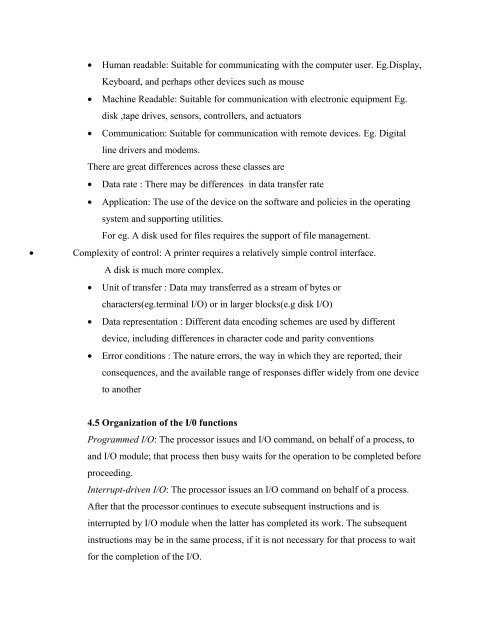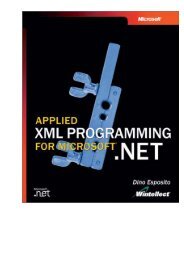I/O Devices and disk scheduling - Csbdu.in
I/O Devices and disk scheduling - Csbdu.in
I/O Devices and disk scheduling - Csbdu.in
You also want an ePaper? Increase the reach of your titles
YUMPU automatically turns print PDFs into web optimized ePapers that Google loves.
• Human readable: Suitable for communicat<strong>in</strong>g with the computer user. Eg.Display,<br />
Keyboard, <strong>and</strong> perhaps other devices such as mouse<br />
• Mach<strong>in</strong>e Readable: Suitable for communication with electronic equipment Eg.<br />
<strong>disk</strong> ,tape drives, sensors, controllers, <strong>and</strong> actuators<br />
• Communication: Suitable for communication with remote devices. Eg. Digital<br />
l<strong>in</strong>e drivers <strong>and</strong> modems.<br />
There are great differences across these classes are<br />
• Data rate : There may be differences <strong>in</strong> data transfer rate<br />
• Application: The use of the device on the software <strong>and</strong> policies <strong>in</strong> the operat<strong>in</strong>g<br />
system <strong>and</strong> support<strong>in</strong>g utilities.<br />
For eg. A <strong>disk</strong> used for files requires the support of file management.<br />
• Complexity of control: A pr<strong>in</strong>ter requires a relatively simple control <strong>in</strong>terface.<br />
A <strong>disk</strong> is much more complex.<br />
• Unit of transfer : Data may transferred as a stream of bytes or<br />
characters(eg.term<strong>in</strong>al I/O) or <strong>in</strong> larger blocks(e.g <strong>disk</strong> I/O)<br />
• Data representation : Different data encod<strong>in</strong>g schemes are used by different<br />
device, <strong>in</strong>clud<strong>in</strong>g differences <strong>in</strong> character code <strong>and</strong> parity conventions<br />
• Error conditions : The nature errors, the way <strong>in</strong> which they are reported, their<br />
consequences, <strong>and</strong> the available range of responses differ widely from one device<br />
to another<br />
4.5 Organization of the I/0 functions<br />
Programmed I/O: The processor issues <strong>and</strong> I/O comm<strong>and</strong>, on behalf of a process, to<br />
<strong>and</strong> I/O module; that process then busy waits for the operation to be completed before<br />
proceed<strong>in</strong>g.<br />
Interrupt-driven I/O: The processor issues an I/O comm<strong>and</strong> on behalf of a process.<br />
After that the processor cont<strong>in</strong>ues to execute subsequent <strong>in</strong>structions <strong>and</strong> is<br />
<strong>in</strong>terrupted by I/O module when the latter has completed its work. The subsequent<br />
<strong>in</strong>structions may be <strong>in</strong> the same process, if it is not necessary for that process to wait<br />
for the completion of the I/O.















